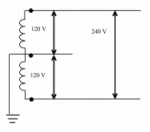View attachment 18576
The picture above shows a 120v/240v system. What you see are two coils that supply 120v, but one coil is electrically 180 degrees out of phase from the other one (this isn't shown in the picture). Think of it as one being "positive" 120v, and the other one being "negative" 120v (I use parenthesis, because this is still AC electricity so there really is no "positive" and "negative", but it helps make my point). When you measure the potential difference across the two, you get 240v.
Now how do you wire a 120v load up to this source? You'll use one of the hot legs (120v) and the middle wire, which is the neutral (you'd also need a ground wire). Current comes out of the top or bottom coils, through the load, and returns on the neutral wire to GND. This brings up the issue of load balancing. It's not good practice to put all 120v loads on one of the 120v coils and not the other. What you should try to do is to balance the 120v loads as much as possible between the top and bottom coils. Both 120v sources share the same neutral. Balancing the loads reduces the current going through the neutral wire. In effect, the current coming from the top and bottom 120v coils "cancel" each other out while flowing on the neutral wire. Best case scenario, if all 120v loads are perfectly balanced, then the neutral will be carrying very little current at that point. 120v loads inside of a panel like this use what are called "single-pole" circuit breakers, because they're only connected to one of the hot legs.
Wiring up 240v loads is just as easy, but instead of connecting the load to one of the hot legs and the neutral, you connect it between both of the 120v legs. This in turn supplies 240v to the load. You don't need to use the neutral in this case. The issue of load balancing does not apply here, because you're already using two out of the two hot legs, there's no other way to connect 240v loads. 240v loads connected inside of a panel like this use what are called "two-pole" breakers, because they're connected to two of the hot legs.
Keep in mind I'm just talking about a 120v/240v system. There's other systems out there such as three-phase three wire or three-phase four wire, and a corner-grounded system in which a previous poster mentioned.



